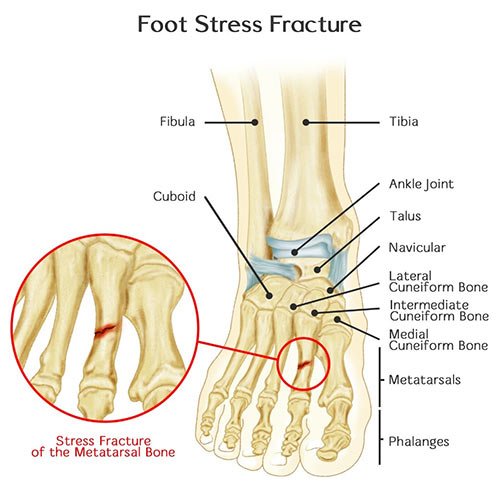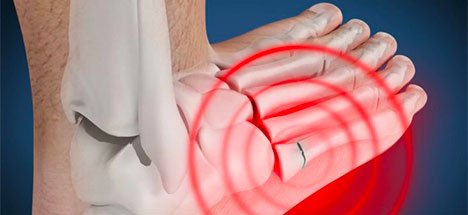What is a Foot Fracture?

Anytime a foot injury is sustained, an immediate visit to the Emergency Room is recommended. Once you have been evaluated, deemed stable, and discharged, the next step is to make an appointment with a foot fracture specialist in NYC. With its 26 bones, the foot is one of the most complex areas of the body; thus, evaluation by a podiatrist is imperative.
In any fracture, we must ensure that the bone has not shifted out of alignment to rule out the need for fracture reduction and/or surgical treatment. Once the fracture is deemed stable, an appropriate treatment plan is implemented to get you on the road to recovery. All symptoms should always be evaluated with a thorough consultation and examination by your podiatrist for an accurate diagnosis and treatment plan to exclude any serious underlying condition.
We also offer treatment options to optimize your natural healing for athletes that need to return to the field quickly.
”
★ ★ ★ ★ ★Dr. Rimawi is one of the best doctors I’ve dealt with. He came across as knowledgeable and confident while at the same time considering many different scenarios before making a final diagnosis of my fractured toe. Looking forward to going back for a follow-up appointment. Strongly recommend.
What are the Types Of Foot Fractures?

Toe fractures and metatarsal fractures are commonly seen in the office setting. In contrast, ankle and calcaneal fractures tend to be diagnosed in the emergency room due to the more severe nature of the injury. Your New York podiatrist provides fracture care and surgery if necessary and prescribes a physical therapy regimen to get you back to health quickly. Visit the best NYC foot doctor to find out more about your foot injuries or fracture.
Fractures are categorized as:
1. Acute or Stress
- An acute fracture is from a sudden injury, like a car accident or fall.
- A stress fracture is from repeated stress over time, like running. Stress fractures are common in the so-called “weekend warrior” group, which refers to those that work a normal desk job during the week but participate in sports on the weekend. In these patients, the bone may not be as strong because an activity is sporadic, not allowing the bone to adapt to stress.
2. Open or Closed
- An open fracture occurs when the skin breaks over the fracture, creating a path for infection to find its way into your broken bones. Open fractures are serious, as they damage the soft tissues around the bone, complicating the treatment process. Please visit the closest emergency room if you suspect an open fracture.
- A closed fracture is a fracture without broken skin.
3. Displaced or Non-Displaced
- A displaced fracture refers to the bones slipping out of alignment after they break. Displaced fractures require the care of an NYC podiatrist to be properly realigned. This may involve metal pins or even plates used to set the bones into place.
- A non-displaced break means the fracture didn’t move the bones out of alignment. These breaks typically heal faster, but you will need to wear a surgical shoe, boot, or cast to prevent stress to the area while they heal.
Your foot doctor in NYC is trained to treat all types of fractures of the foot and ankle, so schedule a visit if you have recently suffered an injury.
What are the Common Causes of Foot Fracture?
A direct injury typically causes acute foot fractures to your foot.
This can happen by any number of means, such as:
- Dropping something on your foot
- Falling awkwardly
- Another person stepping on or kicking your foot
Certain bones can be fractured by badly twisting your ankle or foot. The 5th metatarsal is often fractured during an ankle sprain. A tendon attaches to the base of your 5th metatarsal, which can rip a piece of bone off when the ankle is twisted. Another cause of acute fractures is twisting the foot while landing from a jump or fall. This is a common injury among ballet dancers.
What are the Symptoms of Foot Fracture?
If you fear you’ve suffered a foot or ankle fracture, visit a New York podiatrist. In the case of a high-impact injury, if you are having severe pain, have a highly swollen, bruised foot, or have an open fracture with exposed flesh, please visit the emergency room first to make sure you are medically stable. Emergency rooms are important for acute care, but it is important to visit a specialist for follow-up care and surgical treatment, making an appointment with the best broken foot podiatrist in NYC soon after the injury.
If you have heard a popping sound or crack at the time of injury, you may have a foot fracture or tendon injury. With an acute fracture, you will also experience swelling, pain, and sometimes bruising. You may also have difficulty putting weight on your foot. Many people continue walking with foot pain, not knowing they have a fracture. A foot fracture doctor in NYC is important to be examined after an initial examination by an emergency room physician.
Diagnosis and Treatment
If you are diagnosed with a broken foot, radiographic testing is typically utilized by your foot fracture podiatrist in New York. MRI or CT imaging may also be used for more complex fractures.
Your NYC broken foot doctor must consider several factors when recommending treatment:
- The severity of the damage — how badly the bone is broken
- Which of the five metatarsal bones is broken
- Which area of the bone is fractured
- Whether the fracture is an open or closed fracture
- Whether the broken bone is displaced or non-displaced
- Age of the patient
Some of the basic treatments your foot doctor employs and/or recommends include:
- Ice: Applying ice to your injured foot reduces pain and swelling, but apply it immediately, within 10–30 minutes of your injury. You can create your own ice pack by packing the ice in a plastic bag and wrapping it in a towel. Ice in increments of 20 minutes. You can also put a frozen bag of peas in a towel. Never place ice directly on your skin as it can cause an ice burn. Do not leave ice packs on while you sleep.
- Anti-inflammatory: Motrin and other anti-inflammatory medicines can help reduce pain and swelling to the area and have a long-term improvement in symptoms. Please consult your medical doctor on what medications are safe for you to take.
- Elevation: Raising your foot on a pillow or chair to at least the level of your hip helps reduce swelling by reducing the blood flow to your foot. While you sleep, you can put a pillow under your foot to elevate it.
- Lifestyle changes: Avoid the activity that caused the injury, especially if you suffered a stress fracture, but it also applies to acute fractures. Avoiding activity that creates pain in your mid-foot allows your foot to heal. You may need to use a wheelchair or crutches, which your broken foot doctor in NYC can provide.
- Rest: RRest aids the healing process of a foot fracture, and sometimes it’s the only treatment your broken foot specialist in NYC recommends, even in the case of a traumatic fracture. Healing takes time; give your fracture time to heal before you jump back into your everyday activities.
- Immobilization: Limiting the mobility of your ankle and feet while you wear a cast or another device allows your bones to heal properly. Effective support devices include a rigid boot, plaster casts, or wraps.
- Physical therapy: Follow-up care suggested by your podiatrist ensures that your foot fracture heals completely and you’re less likely to hurt it again. Physical therapy not only gets you back on your feet but also strengthens the surrounding muscles.
- Surgery: In some cases, your NYC foot doctor may suggest a surgical procedure. This is usually when your foot requires re-alignment or additional support that metal pins or plates offer.
Important Reminder: This information is only intended to provide guidance, not definitive medical advice. Please consult a foot doctor about your specific condition. Only a trained, experienced board-certified podiatrist or foot fracture specialist can determine an accurate diagnosis and proper treatment.
Do you have any questions about Foot Fracture Surgery in NYC? Would you like to schedule an appointment with an internationally recognized, top NYC Podiatrists and foot doctors at the Center of Podiatry in New York City? Please contact our office for a consultation.
Dr. Mohammad Rimawi has either authored or reviewed and approved this content. New York City Locations Manhattan Foot Specialists (Upper East Side) 983 Park Ave Ste 1D, New York 10028Manhattan Foot Specialists (Midtown) 56 W 45th St, Ste 802, New York 10036
Manhattan Foot Specialists (Union Square) 55 W 17th St Ste 102, New York 10011
Manhattan Foot Specialists (Financial District) 80 Maiden Lane, Ste 1204, New York 10038
